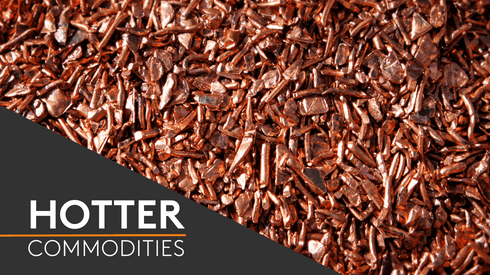The most-traded January copper contract on the SHFE stood at 54,090 yuan ($8,210) per tonne as of 10.32am Shanghai time, up by 240 yuan from the previous session’s close.
Copper prices continue to be supported by news of strike action in Peru and Chile.
“Copper moving up [was] supported to a degree by news from Chile of short-term strike action at BHP’s La Escondida mine in reaction to staff layoffs. There is also ongoing strike action at Southern Peru Copper Corp over pay and benefits,” Sucden Financial said late on Thursday.
Escondida copper mine has laid off about 120 workers, a decision that led to union workers beginning a 24-hour strike on Thursday in protest.
The industrial action has resulted in “the total suspension” of the mine’s operations, Union No.1 said.
“This decision, lacking real and legitimate reasons, is adopted by the company in a post-negotiation scenario and a little over seven months ahead of starting a new negotiation, which allows [one] to attribute to it a character of retaliation and intimidation towards the workers,” the union added.
The strike at Southern Copper mines in Peru continued as no agreement has been reached between union and management, but production is reportedly unaffected.
“These strikes were compounded by another fall in inventories,” ANZ Research said on Friday.
Copper stocks on the London Metal Exchange declined a net 7,200 tonnes to 219,075 tonnes on Thursday.
Meanwhile the rest of the base metals complex was broadly higher, benefiting from a weaker dollar in the aftermath of the US Federal Reserve’s (Fed) more dovish than expected November meeting minutes.
The minutes from the Fed’s November meeting said that some officials were reluctant to vote for additional rate increases until they are convinced that inflation is indeed gaining strength.
These officials “indicated that their decision about whether to increase the target range in the near term would depend importantly on whether the upcoming economic data boosted their confidence that inflation was headed toward the committee’s objective.”
Market participants widely viewed the comments about low inflation as reducing the number of anticipated US interest rate increases next year, sending the dollar lower.
The dollar index was at 93.14 as of 11.09am Shanghai time – the index had reached a low of 93.07 on Thursday, which was the lowest since October 19.
Nickel outperforms but additional support may be needed
- The most-traded May nickel contract on the SHFE jumped by 1,550 yuan or 1.65% to 95,770 yuan per tonne.
- “As the International Nickel Study Group (INSG) reported on Monday, the global nickel market showed a supply deficit of 54,300 tonnes in the first three quarters of the year. This was somewhat higher than in the same period last year. For the year as a whole, the INSG is envisaging a deficit of nearly 100,000 tonnes, which implies a huge shortfall in supply in the fourth quarter,” Commerzbank noted.
- Further support for nickel prices came from reports suggesting Philippine President Rodrigo Duterte is keeping a ban on new open-cast mines in place, according to Sucden Financial Research.
- “Much like the rest of the base metals, we feel nickel prices have already run up considerably and it may now take more evidence of supply shortages before higher prices are justified,” William Adams, Metal Bulletin senior analyst said.
Lead, tin tick higher; aluminium, zinc weaken
- The SHFE’s January lead contract price rose by 165 yuan to 18,465 yuan per tonne.
- The SHFE’s January tin contract price inched up by 270 yuan to 141,970 yuan per tonne.
- The SHFE’s January zinc contract price fell by 60 yuan to 25,490 yuan per tonne.
- The SHFE’s January aluminium contract price edged 10 yuan lower to 14,995 yuan.
Currency moves and data releases
- The dollar index was up by 0.03% to 93.14 as of 11.09am Shanghai time.
- In other commodities, the Brent crude oil spot price was down by 0.07% to $63.35 per barrel, while the Texas light sweet crude oil spot price increased by 0.08% to $58.45.
- In equities, the Shanghai Composite was down by 0.31% to 3,341.48.
- The economic agenda is light today with Japan’s flash manufacturing purchasing managers’ index (PMI) surprising to the upside with a reading of 53.8 in November, from 52.8 in October.
- Later, German Ifo business climate and flash and services PMI data from the United States are due.
| LME snapshot at 02.32am London time | ||
| Latest three-month LME Prices | ||
| Price ($ per tonne) |
Change since yesterday’s close ($) |
|
| Copper | 6,971 | 8 |
| Aluminium | 2,109 | -4 |
| Lead | 2,462.50 | 8.5 |
| Zinc | 3,234 | -4.5 |
| Tin | 19,415 | 15 |
| Nickel | 11,945 | 15 |
| SHFE snapshot at 10.33am Shanghai time | ||
| Most-traded SHFE contracts | ||
| Price (yuan per tonne) |
Change since yesterday’s close (yuan) |
|
| Copper | 54,090 | 240 |
| Aluminium | 14,995 | -10 |
| Zinc | 25,490 | -60 |
| Lead | 18,465 | 165 |
| Tin | 141,970 | 270 |
| Nickel | 95,770 | 1,550 |
| Changjiang spot snapshot on November 24 | ||
| Range (yuan per tonne) |
Change (yuan) |
|
| Copper | 53,960—53,980 | 190 |
| Aluminium | 14,760—14,800 | -20 |
| Zinc | 25,700—26,500 | -140 |
| Lead | 18,400—18,600 | -100 |
| Tin | 141,500—143,000 | -500 |
| Nickel | 95,250—95,450 | 50 |




